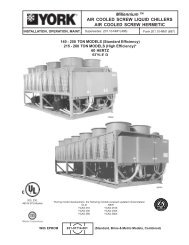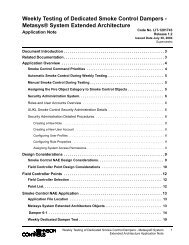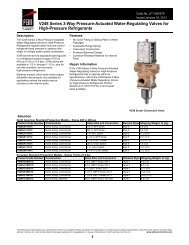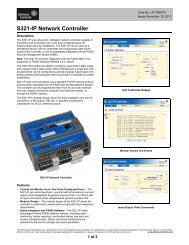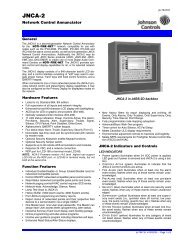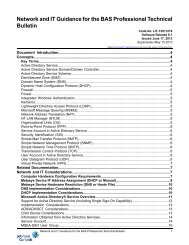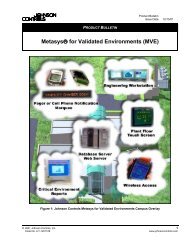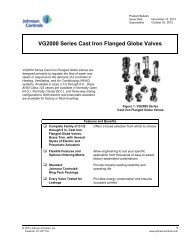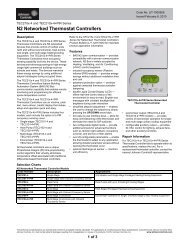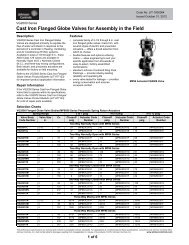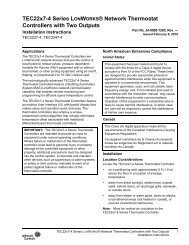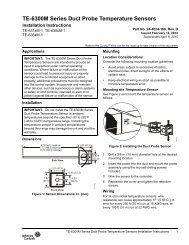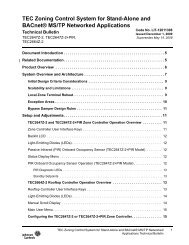YVAA Style A Air-Cooled Screw Liquid Chillers ... - Johnson Controls
YVAA Style A Air-Cooled Screw Liquid Chillers ... - Johnson Controls
YVAA Style A Air-Cooled Screw Liquid Chillers ... - Johnson Controls
Create successful ePaper yourself
Turn your PDF publications into a flip-book with our unique Google optimized e-Paper software.
FORM 201.28-NM1.1<br />
ISSUE DATE: 8/29/2012<br />
SUPPLY TO LOAD<br />
LOAD<br />
BYPASS<br />
RETURN FROM LOAD<br />
LD15049<br />
FIGURE 8 - SUGGESTED LAYOUT FOR APPLICA-<br />
TIONS WITH A FLOW RATE LESS THAN<br />
THE EVAPORATOR MINIMUM ALLOW-<br />
ABLE FLOW RATE<br />
In applications where the required flow rate is greater<br />
than the evaporator’s maximum allowable, the chilled<br />
water can be recirculated to the load.<br />
SUPPLY TO LOAD<br />
FIGURE 9 - SUGGESTED LAYOUT FOR APPLICA-<br />
TIONS WITH A FLOW RATE LESS THAN<br />
THE EVAPORATOR MINIMUM ALLOW-<br />
ABLE FLOW RATE<br />
THERMAL STORAGE<br />
LOAD<br />
BYPASS<br />
RETURN FROM LOAD<br />
LD15049<br />
Thermal storage is the practice of storing cooling energy<br />
during a period of little or no load and/or low energy<br />
costs for use during periods of high load and/or energy<br />
costs. Conventional cooling systems produce cooling<br />
SECTION 4 - INSTALLATION<br />
when it is needed which is commonly during times of<br />
peak demand. Thermal storage allows generation of<br />
cooling capacity to occur during off-peak periods and<br />
store that capacity to meet future cooling requirements.<br />
Using thermal storage can result in smaller equipment<br />
sizes, thereby reducing capital cost, and also can result<br />
in significant energy cost savings<br />
The <strong>YVAA</strong> has special control logic to be able to produce<br />
chilled leaving brine temperatures below 4.4°C<br />
(40°F) so as to supply a storage tank with chilled liquid<br />
during times of low demand. <strong>YVAA</strong> chillers selected<br />
for thermal storage operation can also be selected to efficiently<br />
provide chilled fluid at nominal cooling loads.<br />
VARIABLE PRIMARY FLOW<br />
<strong>Johnson</strong> <strong>Controls</strong> recommends a maximum 10% per<br />
minute flow rate of change, based on design flow, for<br />
variable primary flow applications. Provide 8 to 10 gallons<br />
per chiller ton (8.6 to 10.8 liter per cooling KW)<br />
system water volume. Insufficient system volume and<br />
rapid flow changes can cause control problems or can<br />
even cause chiller shutdowns. There are many other<br />
design issues to evaluate with variable primary flow<br />
systems. Consult your <strong>Johnson</strong> <strong>Controls</strong> Sales Office<br />
for more information about successfully applying<br />
<strong>YVAA</strong> chillers.<br />
CONNECTION TYPES AND SIZES<br />
For connection sizes relevant to individual models refer<br />
to SECTION 5 - TECHNICAL DATA.<br />
EVAPORATOR CONNECTIONS<br />
Standard chilled liquid connections on evaporators<br />
are of the Victaulic Groove type for ASME and PED<br />
marked units and Flange type for GB marked units (see<br />
Figure 11 on page 28 for flange dimensions on GB<br />
marked vessels).<br />
FIGURE 10 - VICTAULIC GROOVE<br />
LD10494<br />
JOHNSON CONTROLS 27<br />
4



